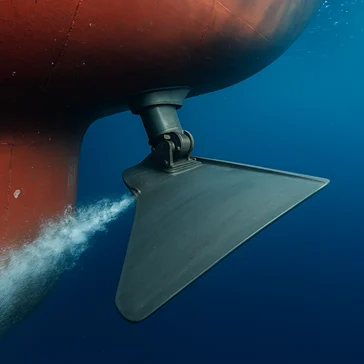When you’re out at sea, stability is everything. A ship that rolls from side to side isn’t just uncomfortable — it can put both crew and cargo at risk. That’s where fin stabilizers step in.
Mounted below the waterline on both sides of the hull, these smart devices work quietly behind the scenes to reduce rolling and keep the vessel steady, making every journey smoother and safer.
What is a Fin Stabilizer?
Think of a fin stabilizer as a ship’s underwater “wings.” These flat, fin-shaped structures are fitted on either side of the vessel. Their job is to push against the water in just the right way to counter the rolling motion caused by waves.
The magic lies in their ability to automatically tilt based on the ship’s movement, reducing roll and helping the vessel stay balanced. You’ll rarely spot them unless the ship is in dry dock, but for any aspiring marine engineer or officer, understanding how they work is a must.
Main Components of a Ship’s Fin Stabilizer System
Here’s a look at the key components that make the stabilizer system work:
- Fins (Port & Starboard)
Each ship has two fins—one on each side. These fins are stored inside fin boxes when not in use. The fins can tilt up to ±25 degrees and move in or out depending on sea conditions.
- Hydraulic Power Units (HPUs)
Located in the stabilizer rooms, the HPUs generate the hydraulic pressure needed to move the fins. Each unit has a powerful electric motor connected to pumps:
A variable delivery piston pump for tilting the fin.
A vane pump for control pressure.
An auxiliary pump for emergency fin stowage.
- Bridge Control Panel (BCP)
Installed on the bridge, this panel allows officers to operate and monitor the fin stabilizers remotely. It’s the main interface used during navigation.
- Local Control Units (LCUs)
Each stabilizer room has its own LCU, which can be used for local control and troubleshooting. It shows fin status and allows manual operation when needed.
- Main Control Unit (MCU)
Located in the Engine Control Room (ECR), the MCU gives engineers full control over the system if the bridge panel is not working. A selector switch can transfer control from the bridge to the engine room.
- Roll Motion Sensor Unit (RMSU)
This sensor measures the ship’s rolling acceleration. It sends real-time data to the MCU, which uses this info to adjust the fin angles and reduce rolling.
- Fin Angle Feedback Transmitter
This transmitter shows the actual tilt angle of the fin. It’s connected to the tilt cylinder and ensures precise feedback to the control system.
- Stroke Control Unit (SCU)
Mounted on the variable delivery pump, the SCU manages the pump’s output. It adjusts the flow of hydraulic oil, controlling how fast and how far the fin tilts.

How Does the Fin Stabilizer System Work?
Let’s understand the operation step-by-step:
- Hydraulic Operation
The HPUs create hydraulic pressure using electric motors and pumps. This pressure powers the fin’s tilting and rigging (in/out) actions. The SCU fine-tunes the pump’s flow rate, ensuring smooth and precise movement.
- Fin Rigging and Emergency Use
The fins can be rigged (extended or stowed) using solenoid valves. In case of a main motor failure, a smaller backup motor and gear pump can safely stow the fins.
- Control from Bridge or ECR
Normal operation is from the Bridge Control Panel (BCP).
In case of failure, the Main Control Unit (MCU) in the engine room can take over.
Local Control Units (LCUs) in the stabilizer rooms allow hands-on operation for maintenance or troubleshooting.
Pre-Operation Safety Checks – Fin Stabilizer System
Before firing up the fin stabilizers, the engine room crew should always run through these essential checks:
Clear the area – Make sure there are no obstructions around the fins or related machinery.
Cooling in check – Verify that cooling water is flowing properly through the HPU heat exchangers.
Power ready – Ensure all isolation switches for controls and pumps are switched ON.
These checks aren’t just routine — they’re your first line of defense against damage and malfunction.
What do you think are the most critical safety steps before starting the fin stabilizer system?
Share your thoughts with us at Nav Insider!


